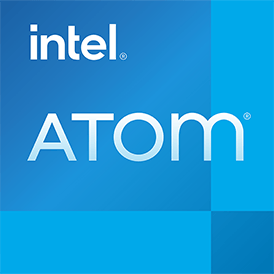Intel Atom x5-Z8350 vs UNISOC T610
Ultimo aggiornamento:
Confronto con benchmark

|

|
|
| Intel Atom x5-Z8350 | UNISOC T610 | |
Confronto CPUIn questo confronto della CPU, confrontiamo Intel Atom x5-Z8350 e UNISOC T610 e utilizziamo i benchmark per verificare quale processore è più veloce.
Confrontiamo il Intel Atom x5-Z8350 4 core processor rilasciato in Q1/2016 con il UNISOC T610 che ha 8 Core della CPU ed è stato introdotto in Q4/2019. |
||
| Intel Atom (108) | Famiglia | UNISOC 4G (10) |
| Intel Atom x3/x5/x7 (9) | Gruppo CPU | UNISOC 4G 12nm (8) |
| 5 | Generazione | 0 |
| Cherry Trail | Architettura | -- |
| Mobile | Segmento | Mobile |
| -- | Predecessore | -- |
| -- | Successore | -- |
|
|
||
CPU Cores e frequenza di baseIl Intel Atom x5-Z8350 è un 4 core processor con una frequenza di clock del 1,44 GHz (1,92 GHz). Il processore può calcolare 4 thread contemporaneamente. UNISOC T610 clock con 1,80 GHz, ha 8 core CPU e può calcolare 8 thread in parallelo. |
||
| Intel Atom x5-Z8350 | Caratteristica | UNISOC T610 |
| 4 | Cores | 8 |
| 4 | Threads | 8 |
| normal | Architettura principale | hybrid (big.LITTLE) |
| No | Hyperthreading | No |
| No | Overclocking ? | No |
| 1,44 GHz (1,92 GHz) | A-Core | 1,80 GHz 2x Cortex-A75 |
| -- | B-Core | 1,80 GHz 6x Cortex-A55 |
Grafica internaLa grafica (iGPU) integrata nel processore non solo consente l'output delle immagini senza dover fare affidamento su una soluzione grafica dedicata, ma può anche accelerare in modo efficiente la riproduzione video. |
||
| Intel HD Graphics 400 | GPU | ARM Mali-G52 MP2 |
| 0,20 GHz | Frequenza GPU | 0,61 GHz |
| 0,50 GHz | GPU (Turbo ) | -- |
| 8 | GPU Generation | Bifrost 2 |
| 14 nm | Tecnologia | 16 nm |
| 3 | Max. visualizzazioni | 2 |
| 12 | Unità di esecuzione | 2 |
| 96 | Shader | 32 |
| No | Hardware Raytracing | No |
| No | Frame Generation | No |
| 8 GB | Max. GPU Memoria | -- |
| 12 | DirectX Version | 12 |
Hardware codec supportUn codec fotografico o video accelerato nell'hardware può accelerare notevolmente la velocità di lavoro di un processore e prolungare la durata della batteria di notebook o smartphone durante la riproduzione di video. |
||
| Intel HD Graphics 400 | GPU | ARM Mali-G52 MP2 |
| No | Codec h265 / HEVC (8 bit) | Decodificare / Codificare |
| No | Codec h265 / HEVC (10 bit) | Decodificare / Codificare |
| Decodificare / Codificare | Codec h264 | Decodificare / Codificare |
| No | Codec VP9 | Decodificare / Codificare |
| Decodificare | Codec VP8 | Decodificare / Codificare |
| No | Codec AV1 | No |
| Decodificare / Codificare | Codec AVC | Decodificare / Codificare |
| Decodificare | Codec VC-1 | Decodificare / Codificare |
| Decodificare | Codec JPEG | Decodificare / Codificare |
Memoria & PCIe2 GB di memoria in un massimo di 1 canali di memoria sono supportati da Intel Atom x5-Z8350, mentre UNISOC T610 supporta un massimo di GB di memoria con una larghezza di banda di memoria massima di -- abilitata. |
||
| Intel Atom x5-Z8350 | Caratteristica | UNISOC T610 |
| DDR3L-1600 | Memoria | LPDDR4X-1600, LPDDR4-1600, LPDDR3-933 |
| 2 GB | Max. Memoria | |
| 1 (Single Channel) | Canali di memoria | 0 |
| 12,8 GB/s | Max. Larghezza di banda | -- |
| No | ECC | No |
| -- | L2 Cache | -- |
| 2,00 MB | L3 Cache | -- |
| 2.0 | Versione PCIe | -- |
| 1 | Linee PCIe | -- |
| 0,5 GB/s | PCIe Larghezza di banda | -- |
Gestione termicaIntel Atom x5-Z8350 ha un TDP di 2 W. Il TDP di UNISOC T610 è --. Gli integratori di sistema utilizzano il TDP del processore come guida per il dimensionamento della soluzione di raffreddamento. |
||
| Intel Atom x5-Z8350 | Caratteristica | UNISOC T610 |
| 2 W | TDP (PL1 / PBP) | -- |
| -- | TDP (PL2) | -- |
| -- | TDP up | -- |
| -- | TDP down | -- |
| -- | Tjunction max. | -- |
Dettagli tecniciIntel Atom x5-Z8350 ha 2,00 MB di cache ed è prodotto in 14 nm. La cache di UNISOC T610 è a 0,00 MB. Il processore è prodotto in 12 nm. |
||
| Intel Atom x5-Z8350 | Caratteristica | UNISOC T610 |
| 14 nm | Tecnologia | 12 nm |
| Monolitico | Design a chip | Sconosciuto |
| x86-64 (64 bit) | Set di istruzioni (ISA) | Armv8-A (64 bit) |
| SSE4.1, SSE4.2 | Estensioni ISA | -- |
| BGA 592 | Presa | -- |
| VT-x, VT-x EPT | Virtualizzazione | Nessuno |
| Si | AES-NI | No |
| Sistemi operativi | Android | |
| Q1/2016 | Data di lancio | Q4/2019 |
| 18 $ | Prezzo di rilascio | -- |
| mostra più dati | mostra più dati | |
Valuta questi processori
Performance media nei benchmark
⌀ Prestazioni single core in 2 benchmark CPU
⌀ Prestazioni multi-core in 2 benchmark CPU
Geekbench 5, 64bit (Single-Core)
Geekbench 5 è un benchmark multi-piattaforma che usa in modo intensivo la memoria del sistema.Il test single-core utilizza solo un nucleo elaborativo della CPU. A tal fine, il numero di nuclei elaborativi o la capacità di hyperthreading non sono rilevanti.
|
|
Intel Atom x5-Z8350
4C 4T @ 1,92 GHz |
||
|
|
UNISOC T610
8C 8T @ 1,80 GHz |
||
Geekbench 5, 64bit (Multi-Core)
Geekbench 5 è un benchmark multi-piattaforma che usa in modo intensivo la memoria del sistema.Il test multi-core coinvolge tutti i nuclei elaborativi della CPU e si avvale del hyperthreading.
|
|
Intel Atom x5-Z8350
4C 4T @ 1,92 GHz |
||
|
|
UNISOC T610
8C 8T @ 1,80 GHz |
||
Geekbench 6 (Single-Core)
Geekbench 6 è un punto di riferimento per computer, notebook e smartphone moderni. Ciò che è nuovo è un utilizzo ottimizzato delle architetture CPU più recenti, ad esempio basate sul concetto big.LITTLE e combinando core CPU di diverse dimensioni. Il benchmark single-core valuta solo le prestazioni del core della CPU più veloce, il numero di core della CPU in un processore è irrilevante qui.
|
|
Intel Atom x5-Z8350
4C 4T @ 1,92 GHz |
||
|
|
UNISOC T610
8C 8T @ 1,80 GHz |
||
Geekbench 6 (Multi-Core)
Geekbench 6 è un punto di riferimento per computer, notebook e smartphone moderni. Ciò che è nuovo è un utilizzo ottimizzato delle architetture CPU più recenti, ad esempio basate sul concetto big.LITTLE e combinando core CPU di diverse dimensioni. Il benchmark multi-core valuta le prestazioni di tutti i core della CPU del processore. I miglioramenti del thread virtuale come AMD SMT o l'Hyper-Threading di Intel hanno un impatto positivo sul risultato del benchmark.
|
|
Intel Atom x5-Z8350
4C 4T @ 1,92 GHz |
||
|
|
UNISOC T610
8C 8T @ 1,80 GHz |
||
iGPU - Prestazioni FP32 (GFLOPS a precisione singola)
Le prestazioni di calcolo teoriche dell'unità grafica interna del processore con precisione semplice (32 bit) in GFLOPS. GFLOPS indica quanti miliardi di operazioni in virgola mobile che l'iPPU può eseguire al secondo.
|
|
Intel Atom x5-Z8350
Intel HD Graphics 400 @ 0,50 GHz |
||
|
|
UNISOC T610
ARM Mali-G52 MP2 @ 0,61 GHz |
||
Cinebench R23 (Single-Core)
Cinebench R23 è il successore di Cinebench R20 ed è anch'esso basato su Cinema 4D. Cinema 4D è un software usato a livello mondiale per creare forme in 3D. Il test single-core utilizza solo un nucleo elaborativo della CPU. A tal fine, il numero di nuclei elaborativi o la capacità di hyperthreading non sono rilevanti.
|
|
Intel Atom x5-Z8350
4C 4T @ 1,92 GHz |
||
|
|
UNISOC T610
8C 8T @ 1,80 GHz |
||
Cinebench R23 (Multi-Core)
Cinebench R23 è il successore di Cinebench R20 ed è anch'esso basato su Cinema 4D. Cinema 4D è un software usato a livello mondiale per creare forme in 3D. Il test multi-core coinvolge tutti i nuclei elaborativi della CPU e si avvale del hyperthreading.
|
|
Intel Atom x5-Z8350
4C 4T @ 1,92 GHz |
||
|
|
UNISOC T610
8C 8T @ 1,80 GHz |
||
Cinebench R20 (Single-Core)
Cinebench R20 è il successore di Cinebench R15 ed è anch'esso basato su Cinema 4D. Cinema 4D è un software usato a livello mondiale per creare forme in 3D. Il test single-core utilizza solo un nucleo elaborativo della CPU. A tal fine, il numero di nuclei elaborativi o la capacità di hyperthreading non sono rilevanti.
|
|
Intel Atom x5-Z8350
4C 4T @ 1,92 GHz |
||
|
|
UNISOC T610
8C 8T @ 1,80 GHz |
||
Cinebench R20 (Multi-Core)
Cinebench R20 è il successore di Cinebench R15 ed è anch'esso basato su Cinema 4D. Cinema 4D è un software usato a livello mondiale per creare forme in 3D. Il test multi-core coinvolge tutti i nuclei elaborativi della CPU e si avvale del hyperthreading.
|
|
Intel Atom x5-Z8350
4C 4T @ 1,92 GHz |
||
|
|
UNISOC T610
8C 8T @ 1,80 GHz |
||
Risultati stimati da PassMark CPU Mark
Alcune delle CPU elencate di seguito sono stati sottoposti a benchmarking da CPU-monkey. Tuttavia, la maggior parte delle CPU non sono state testate e i risultati sono stati stimati utilizzando una formula segreta di proprietà di CPU-monkey. Come tali, essi non riflettono con precisione i valori attuali di Passmark CPU Mark e non sono stati approvati da PAssMark Software Pty Ltd.
|
|
Intel Atom x5-Z8350
4C 4T @ 1,92 GHz |
||
|
|
UNISOC T610
8C 8T @ 1,80 GHz |
||
CPU-Z Benchmark 17 (Multi-Core)
Il benchmark CPU-Z misura le prestazioni di un processore misurando il tempo impiegato dal sistema per completare tutti i calcoli del benchmark. Più velocemente viene completato il benchmark, maggiore è il punteggio.
|
|
Intel Atom x5-Z8350
4C 4T @ 1,44 GHz |
||
|
|
UNISOC T610
8C 8T @ 1,80 GHz |
||
Cinebench R15 (Single-Core)
Cinebench R15 è il successore di Cinebench 11.5 ed è anch'esso basato su Cinema 4D. Cinema 4D è un software usato a livello mondiale per creare forme in 3D. Il test single-core utilizza solo un nucleo elaborativo della CPU. A tal fine, il numero di nuclei elaborativi o la capacità di hyperthreading non sono rilevanti.
|
|
Intel Atom x5-Z8350
4C 4T @ 1,92 GHz |
||
|
|
UNISOC T610
8C 8T @ 1,80 GHz |
||
Cinebench R15 (Multi-Core)
Cinebench R15 è il successore di Cinebench 11.5 ed è anch'esso basato su Cinema 4D. Cinema 4D è un software usato a livello mondiale per creare forme in 3D. Il test multi-core coinvolge tutti i nuclei elaborativi della CPU e si avvale del hyperthreading.
|
|
Intel Atom x5-Z8350
4C 4T @ 1,92 GHz |
||
|
|
UNISOC T610
8C 8T @ 1,80 GHz |
||
Dispositivi che utilizzano questo processore |
|
| Intel Atom x5-Z8350 | UNISOC T610 |
| Sconosciuto | Sconosciuto |
I confronti più popolari che contengono questa CPU
Torna all'indice


